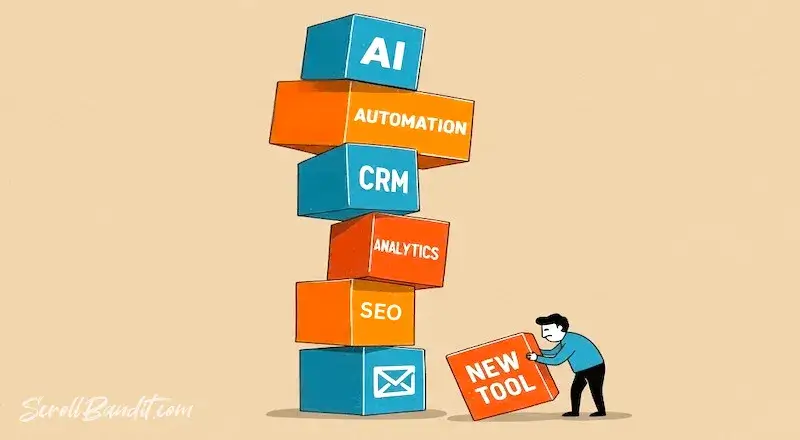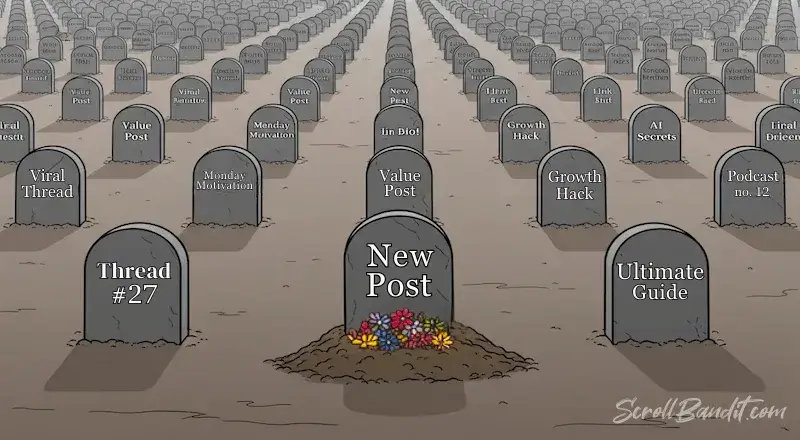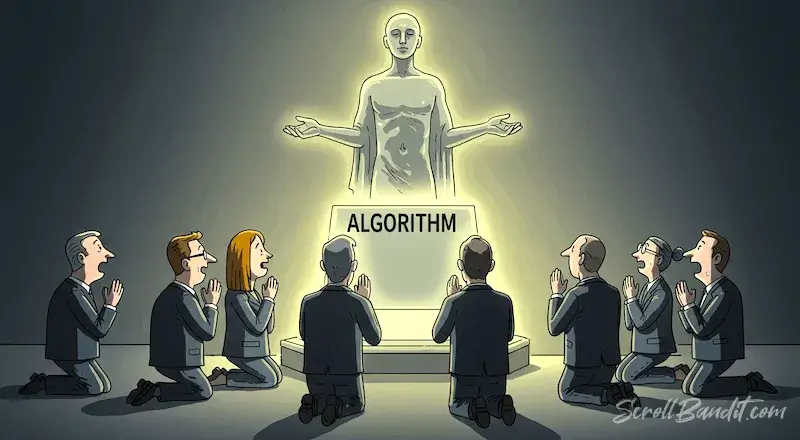Everyone in marketing looks cooked.
Clients. Freelancers. Agencies.
Even the “personal brand” guys are begging their LinkedIn posts to convert.
Some days, this is what it feels like.
People keep asking “is digital marketing hard now?”
Yeah. It is. And not for the reasons you think.
It’s not the algorithm. It’s not “AI taking over.”
It’s the mountain of bullshit we’ve built ourselves.
Every tool screams “10x your results.”
Every post is another recycled hot take.
Every client expects magic because someone on TikTok promised it’s easy.
We’re drowning in hacks, dashboards, and shiny tech while forgetting the one thing that ever mattered: people.
The web didn’t get harder. We just buried the good stuff under layers of noise and nonsense.
So here it is. Six brutal truths about where digital marketing’s really at, and how to keep your sanity while everyone else burns out pretending they’re crushing it.
Everyone’s a Marketer Now, and That’s the Problem
The internet handed a megaphone to every amateur with a Canva account and a ChatGPT tab open.
Now the web’s flooded with “experts” who couldn’t sell a sandwich in real life but somehow have a course on “audience psychology.”
They post the same AI-written “5 Tips for Brand Growth” carousel, throw in a funnel diagram they don’t understand, and call it a strategy.
And clients eat it up until it doesn’t work. Then they show up in your inbox, already skeptical, already burned.
This is what happens when marketing looks too easy.
When tools do the talking, craft disappears.
And when everyone’s shouting, even solid work gets ignored because it sounds like the rest of the noise.
Here’s the kicker. This flood of fake expertise doesn’t just waste money. It erodes trust.
Real marketers are now guilty by association. You’re not starting at zero; you’re starting in the negative because some LinkedIn guru promised a “viral system” for $49.
The fix:
Don’t try to outpost the bullshitters. Outthink them.
Clarity beats volume every time.
Show strategy, not noise. Break down your decisions. Educate your clients as you go.
People can smell fake. Give them something real to compare it to.
If your work still looks simple from the outside, good.
That’s the point. The loud ones look busy. The smart ones look boring until the results land.
The Tool Stack Is Eating the Work
Remember when marketing meant understanding people?
Now it means remembering passwords.
Every week there’s a “game-changing” platform. Every demo promises to automate the bits you already know how to do.
Your workflow’s not a system anymore. It’s a circus.

You’ve got dashboards talking to dashboards.
A tool to track the tools.
A report that tells you what the other report already told you, just with shinier charts.
Marketers love to say they’re “data-driven,” but most of us are just button-driven, clicking through setups we don’t even trust.
And here’s the real cost: the more you chase efficiency, the less time you spend on actual thinking.
Automation should amplify judgment, not replace it.
Instead, it’s turned half the industry into spreadsheet operators with fancy job titles.
The fix:
Cut the tool bloat. Audit every app you use and kill half of them.
If something isn’t saving real time or helping you make smarter calls, it’s just noise with a subscription fee.
Learn your remaining tools inside out.
Make them boringly reliable so you can get back to the part that actually matters: knowing people, not platforms.
Because here’s the uncomfortable truth. No one ever built great marketing out of a stack.
They built it out of insight, timing, and a bit of reckless experimentation.
Clients Want Miracles, Not Marketing
Every client wants a silver bullet.
“Can we get 10x ROI in 30 days?”
Sure. If you invent a time machine and buy ad space in 2015.
The problem isn’t that clients are stupid.
It’s that half the industry keeps feeding them fairytales.
Case studies written like Marvel scripts. “We scaled from zero to millions overnight.” Yeah, with a budget you didn’t mention and a product people already wanted.
Most clients don’t understand marketing. Why would they? It’s your job.
But instead of educating them, too many marketers perform magic tricks.
They show surface-level numbers, hide the real work, and hope no one asks what any of it means.
Then the campaign dips, and suddenly you’re the villain who “didn’t deliver.”
They forget the testing, the iterations, the time it takes for anything good to build.
You sold certainty in a business that runs on variables. That’s not confidence. That’s bullshit.
The fix:
Be the adult in the room. Set expectations before the first ad runs.
Show the plan, the process, and the trade-offs.
If they want miracles, tell them to try church.
If they want marketing, show them how boring it actually is when it’s done right.
The right clients respect truth, even when it stings.
The wrong ones leave. Let them. They’re someone else’s future “why our agency failed” Reddit post.
Content Isn’t King Anymore. Attention Is.
Everyone’s churning out “content.”
Threads. Reels. Carousels. AI posts about “authentic storytelling.”
Half of it sounds like ChatGPT trying to be a life coach.
We’ve turned marketing into performance art.
It’s not about connecting anymore. It’s about looking like you’re connecting.
As long as it’s “educational” and sprinkled with emojis, people think it’s strategy.
But here’s the truth: nobody cares.
The internet is a landfill of “value.”
Your precious post is sitting between a cat video and a crypto bro explaining discipline.

Attention is the new currency.
You don’t earn it with effort. You earn it by being interesting, fast, and impossible to ignore.
That doesn’t mean dumbing down. It means giving people a reason to stop scrolling.
The fix:
Stop writing like a marketing textbook.
Be opinionated. Be funny. Be weird. Anything but beige.
One sharp take beats ten “insightful” posts no one remembers.
Talk like a person, not a brand guidelines PDF.
And please, stop telling people to “add value.”
They’re drowning in it. What they need is a pulse.
Metrics Are Making You Stupid
Somewhere along the way, we started worshipping dashboards.
Open any agency Slack and someone’s posting charts like they’ve discovered religion.
The colors are pretty. The numbers look important.
But half of it means nothing.
Likes don’t pay rent. Impressions don’t build trust.
You can’t take engagement rate to the bank.
Marketers love the comfort of big numbers because they feel like progress.
It’s easier to chase clicks than to ask if the right people are clicking.
Easier to optimize for volume than to question what the hell the volume even means.
Metrics are supposed to help us make decisions.
Now they’ve turned into a distraction that keeps us busy instead of better.
Here’s the hard truth: if your reporting doesn’t connect to money, retention, or reputation, it’s just noise with a chart.
And if you’re spending more time proving success than creating it, you’re not doing marketing. You’re doing politics.
The fix:
Cut your metrics list in half.
Then cut it again.
Track what actually changes the business, not what flatters the report.
Learn to say, “That number’s irrelevant,” and mean it.
Good marketers chase results. Great ones know which results matter.
Burnout Is the New Normal (But It Doesn’t Have to Be)
Everyone’s running on fumes.
Every update, every trend, every new “must-have” tool is another thing to chase.
Half the industry is tired. The other half is pretending not to be.
We’ve built a culture that rewards overwork and calls it ambition.
If you’re not tweeting at midnight or “always learning,” someone else will be.
That’s the lie. The machine runs on burnout, and everyone claps until they crash.
Marketing isn’t supposed to be a 24/7 panic attack.
You don’t do your best thinking when you’re fried. You just hit deadlines faster and worse.
And yeah, there’s a bit of irony here. We’re all out here telling people to rest while secretly refreshing analytics like addicts.
The difference between surviving this game and hating it is learning when to close the damn laptop.
The fix:
Rest isn’t lazy. It’s a reset.
Take time away from screens. Get bored again.
The good ideas show up when you stop forcing them.
If you want longevity in this industry, protect your curiosity like a client.
Because when you lose that, no tool, no trend, no “growth hack” can save you.
The Real Truth
Marketing isn’t dead. It’s just buried under bullshit.
The fake experts, the shiny tools, the fake urgency. We built it all.
Then we sat around wondering why it feels harder than ever.
It’s not the algorithms or the AI. It’s us.
We traded thinking for templates. Craft for hacks. People for performance metrics.
But the good news? You can still win by doing less.
Simpler tools. Fewer promises. Sharper ideas.
The web might be chaos, but the basics still work. Talk like a human. Sell something useful. Repeat.
The rest is just noise trying to look clever.
Cut through it.
Call it out.
Then go build something worth clicking on.

